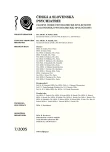Schizophrenia at Childhood and Adolescence
Schizofrenie v dětství a adolescenci
Z výzkumu vyplývá, že dvě charakteristiky byly při výzkumu schizofrenie validní, speciálně u schizofrenie v dětství a adolescenci, a to perinatální poškození a zvýšená dráždivost nervového systému. Dráždivost je zapříčiněná nedokonalou souhrou excitačního a inhibičního systému. U nemocných je mírně vyšší výskyt neurodegenerativních stigmat (tzv. kraniofaciální dysmorfie). Rovněž častější výskyt velokardiofaciálního syndromu Di George (VCFS). Neuropatologické a cytoarchitektonické změny v limbických strukturách, v hipokampu, septu, corpus callosi, v temporálních a frontálních lalocích, změny mozkokomorového poměru a celkové mozkové asymetrie potvrzují model intrauterinně naprogramované „chyby“ a jsou markerem vulnerability u rizikového jedince.
Genetické faktory determinují fyzickou bázi osobnosti (její odolnost), ale psychická porucha je výsledkem precipitace vlivu genetických, biologicko-organických, vývojových a enviromentálních vlivů. Neurovývojová teorie vzniku schizofrenie předpokládá, že vloha onemocnění je přítomna, a proto zjistitelná již od nejčasnějších stadií života jedince a projevuje se jednak fyziologickými a biochemickými, jednak kognitivními a psychologickými odchylkami od normálního průběhu vývoje.
Klíčová slova:
perinatální komplikace, fyzické anomálie a vývojové abnormality u schizofrenie, speciálně u schizofrenie s časným začátkem, velocardiofaciální syndrom Di George (VCFS).
Authors:
E. Malá
Authors‘ workplace:
Dětská psychiatrická klinika 2. LF UK a FN Motol, Praha
přednosta doc. MUDr. M. Hrdlička, CSc.
; Institut postgraduálního vzdělávání ve zdravotnictví, Praha
ředitel MUDr. A. Malina, Ph. D.
Published in:
Čes. a slov. Psychiat., 101, 2005, No. 7, pp. 357-361.
Category:
Comprehensive Reports
Overview
The research indicated that two characteristics were valid for the research in schizophrenia, especially in schizophrenia at the child age and adolescence, specifically perinatal damage and increased irritability of the nervous system. The irritability is caused by imperfect coordination of the excitation and inhibition system. In these patients there is a slightly higher occurrence of neurodegenerative stigmata (s.c. craniofacial dysmorphia). There is also a more frequent occurrence of velocardiofacial syndrome Di George/VCFS). Neuropathological and cytoarchitectonic changes in limbic structures, in hippocampus, septum, corpus callosum, in temporal and frontal lobes, changes in brain/chamber ratio and general brain asymmetry confirm the model of intrauterine programmed “error” and represent a marker of vulnerability in the individual at risk. Genetic factors determine the physical basis of the personality (resistance), but psychic disorder is the results of precipitation of the effects of genetic, biological-organic, developmental and environmental factors. Neurodevelopmental theory on the origin of schizophrenia assumes that inclination to the disease is present and can be therefore determined from the earliest stages of the individual’s life and becomes manifest in biological and biochemical as well as cognitive and psychological deviations from normal course of development.
Key words:
perinatal complications, physical anomalies and developmental abnormalities in schizophrenia with early origin, velocardiofacial syndrome DiGeorge/VCFS).
Labels
Addictology Paediatric psychiatry PsychiatryArticle was published in
Czech and Slovak Psychiatry

2005 Issue 7
- Memantine Eases Daily Life for Patients and Caregivers
- Hope Awakens with Early Diagnosis of Parkinson's Disease Based on Skin Odor
- Memantine in Dementia Therapy – Current Findings and Possible Future Applications
- Deep stimulation of the globus pallidus improved clinical symptoms in a patient with refractory parkinsonism and genetic mutation
Most read in this issue
- Consideration of Specific Credibility of Statement in Case of Sexual Abuse
- Evaluation of Cannabis, Ecstasy and Methamphetamine Use in Pharmacy Students: Results of Urinalysis
- Melancholia in the Classifications of Mental Disorders MKCH-10 and DSM-IV
- Schizophrenia at Childhood and Adolescence
